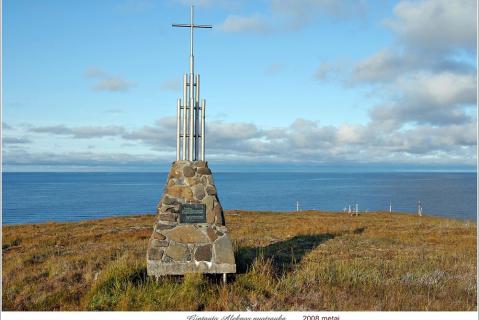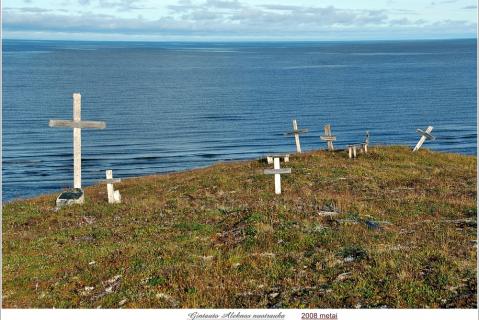In 1942-1947, forced settlers from the Leningrad Region (mainly Finns), deported Lithuanians and forcibly mobilised inhabitants of Yakutia’s Churpanchinsky district, were all sent to the Muostakh headland to work in the fishing industry. There was high mortality among the deportees in the winter of 1942/1943 due to hunger, cold and infectious diseases. The graveyard was built on a high bank above the sea and the dead were buried in individual graves. The numbers buried there have not been established; a list of Lithuanian deportees has been published in Lithuania. At the end of the 1940s the fishery closed, the settlers dispersed, and the graveyard was abandoned. Storms destroyed much of the graveyard and many of the burials were washed into the sea.
In 1989, an expedition from Lithuania erected a monument in the graveyard. The inscription in four languages (Lithuanian, Russian, Yakut and Finnish) reads: “Forcibly torn from their native land, fallen but not forgotten”.
Research on the Genocide of the Lithuanian People (Lietuvos gyventoju Genocidas; 3 vols. 1999-2009) contains about 130,000 biographical entries (in Lithuanian). Vols 1 & 2 cover the period from 1939 to 1947 and see Deportation of Lithuanians, 1941-1951 for the 28 other burial grounds and commemorative sites on the Map of Memory.
The List of Repressed Finns (18,000 names in Latin and Cyrillic scripts).
The Memorial online database (2025) lists 9,675 victims in the Republic of Sakha (BR 7,417).
402 were condemned to death; charges against 2,145 were dropped (23 died in captivity). Over 3,000 were sent to the camps. The Book of Remembrance and police records name families and individuals (total 3,860) who became forced settlers and deportees or were born in Yakutia’s special settlements (1,103): 93 were accused of belonging to the OUN (Organisation of Ukrainian Nationalists), 401 were “kulaks”, 746 Soviet Germans, and 430 sent to the Bulunsky district (almost all born in the Leningrad Region).
| State of burials | Area | Boundaries |
|---|---|---|
|
Several grave crosses have survived
|
not defined
|
not delineated
|
[ Original texts & hyperlinks ]
Lithuanians in the Arctic [Lietuviai Arktyje], compiled by Markauskas and J.R. Puodzius; The Brotherhood of the Laptev Sea Exiles, Kaunas, 2000 (112 pp; in English)
“Muostakh headland. Forced labourers and settlers graveyard”, Virtual Museum of the Gulag [retrieved, 26 May 2022; no longer accessible]


